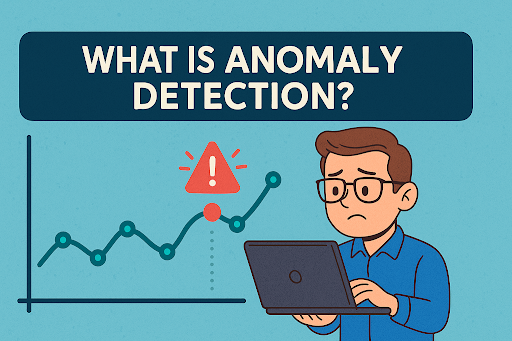Can Your System Spot the Unexpected?
Updated on June 18, 2025, by ITarian

Imagine you’re managing a secure network, and suddenly, an employee’s computer begins uploading gigabytes of data at 3 a.m.—when no one is working. Would you notice? This is where anomaly detection becomes essential.
What is anomaly detection? It’s a critical technology used in cybersecurity and IT infrastructure to automatically spot behavior that deviates from the norm. Whether it’s detecting fraud, identifying system failures, or flagging suspicious user activity, anomaly detection plays a vital role in preventing threats before damage is done.
In this post, we’ll break down the meaning, mechanics, and business value of anomaly detection, including types of anomaly detection, real-time applications, and the algorithms that power it.
What is Anomaly Detection?
Anomaly detection is the process of identifying data points, patterns, or events that deviate significantly from the expected norm. These anomalies could represent errors, fraud, system failures, or malicious activity—making them crucial for automated alert systems.
Why It Matters:
- Unusual behavior can signal cyberattacks, system malfunctions, or operational inefficiencies.
- In cybersecurity, anomaly detection helps detect zero-day attacks, insider threats, and ransomware indicators.
Types of Anomaly Detection
There are several ways to classify anomalies, depending on the nature of the data and context. Let’s explore the primary types of anomaly detection systems:
1. Point Anomalies
- A single data point is significantly different from the rest.
- Example: A $10,000 transaction in a $100 average-spending account.
2. Contextual Anomalies
- The anomaly depends on the context or environment.
- Example: High CPU usage during backups is normal, but suspicious at idle hours.
3. Collective Anomalies
- A group of related data points deviates from the pattern.
- Example: Sudden spikes in login attempts across multiple endpoints.
4. Behavioral Anomalies
- Deviations from individual user or system behavioral baselines.
- Example: An employee downloading large data files outside office hours.
Understanding the different types of anomaly detection helps tailor systems to specific cybersecurity use cases.
How Anomaly Detection Works
Anomaly detection systems use mathematical models, machine learning, and statistical analysis to determine what “normal” looks like—then flag deviations in real time.
Core Steps in the Process:
- Data Collection
- Network logs, user activity, system metrics
- Data Profiling
- Establish baseline behavior
- Model Building
- Use rules or algorithms to detect outliers
- Detection & Alerting
- Real-time anomaly flagging
- Action & Feedback
- Incident response, system learning, or manual review
Anomaly Detection Algorithms
The engine behind anomaly detection is the algorithm. Some use simple statistical thresholds, while others apply machine learning for dynamic adaptation.
Popular Algorithms Include:
1. Z-Score / Statistical Methods
- Detects values that fall outside standard deviation thresholds.
2. K-Means Clustering
- Groups data into clusters; anomalies fall outside these clusters.
3. Isolation Forest
- An ensemble learning method that isolates anomalies quickly.
4. Autoencoders (Neural Networks)
- Learn data representations and identify differences with high accuracy.
5. One-Class SVM (Support Vector Machine)
- Trains on normal data only; flags anything that doesn’t fit the pattern.
Matching Algorithms to Use Cases:
| Use Case | Recommended Algorithm |
| Network Intrusion Detection | Isolation Forest, SVM |
| Financial Fraud | Z-Score, Autoencoder |
| User Behavior Analytics | Clustering, Neural Networks |
Real-Time Anomaly Detection in Cybersecurity
Modern cyber threats don’t wait. That’s why real-time anomaly detection is critical for rapid response and containment.
How It Helps:
- Detect malware infections in early stages
- Identify lateral movement in networks
- Stop insider threats before data exfiltration
- Flag unusual login patterns or access privileges
Common Tools Using Real-Time Detection:
- SIEM systems (e.g., Splunk, IBM QRadar)
- UEBA (User and Entity Behavior Analytics)
- Cloud security platforms (AWS GuardDuty, Azure Sentinel)
Benefits of Anomaly Detection in Cybersecurity
✔️ Early Threat Detection
Identify problems before they escalate.
✔️ Reduced False Positives
Advanced algorithms improve precision.
✔️ Scalability
Suitable for enterprises with massive and complex data sets.
✔️ Automation & Speed
Faster reaction to security incidents.
✔️ Context-Aware Security
Adapts to evolving threats in dynamic environments.
Challenges and Limitations
While anomaly detection is powerful, it’s not flawless.
⚠️ High False Positives (in poorly tuned systems)
Requires ongoing optimization.
⚠️ Data Quality Dependence
Garbage in = garbage out. Clean, labeled data is essential.
⚠️ Model Complexity
Advanced machine learning models require expertise to deploy and maintain.
⚠️ Adversarial Behavior
Sophisticated attackers can try to mimic “normal” behavior.
Best Practices for Deploying Anomaly Detection
- Start With Defined Objectives
- Fraud detection? Insider threat? Network intrusion?
- Use Hybrid Detection Models
- Combine statistical and ML-based approaches for better accuracy.
- Integrate with Existing Tools
- Feed outputs into your SIEM or SOAR system for automated responses.
- Continuously Train Models
- Update baselines and retrain based on new behavior.
- Collaborate Across Teams
- Security, IT, and data science teams should co-own system success.
FAQs About Anomaly Detection
1. What is anomaly detection used for?
It’s used to identify irregular patterns in data that could signal fraud, cyberattacks, equipment failure, or policy violations.
2. What industries benefit most from anomaly detection?
Cybersecurity, finance, healthcare, manufacturing, and e-commerce—anywhere large datasets and high risk are involved.
3. How does anomaly detection improve cybersecurity?
It enables real-time threat identification, minimizes breaches, and enhances incident response by spotting behavior that traditional systems might miss.
4. Is anomaly detection only for large enterprises?
No. With cloud-based tools and SaaS platforms, even small businesses can deploy affordable anomaly detection.
5. What’s the difference between anomaly detection and rule-based alerts?
Rule-based systems rely on pre-set conditions. Anomaly detection adapts to dynamic, evolving behavior using intelligent models.
Final Thoughts: Don’t Let the Unusual Go Unnoticed
With cyber threats becoming more automated, subtle, and fast-moving, traditional defenses are no longer enough. Anomaly detection offers a proactive shield—helping you find what doesn’t belong before it causes damage.
By understanding what anomaly detection is, how it works, and where to apply it, your organization can make smarter, faster, and more secure decisions.
🚀 Ready to enhance your detection capabilities?














